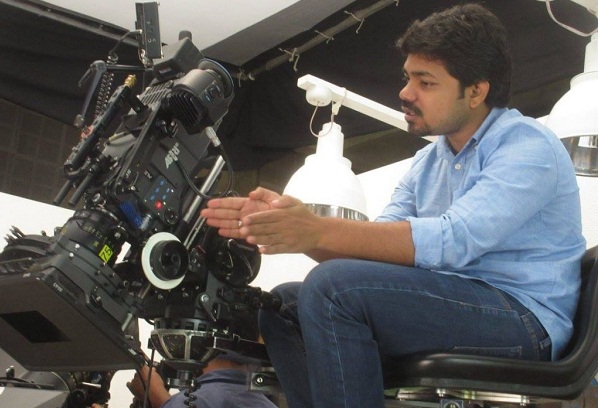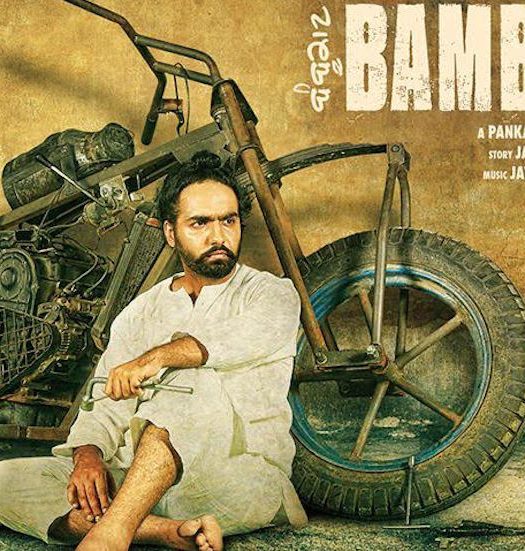My lensing and lighting was a reaction to the performances: Avinash
A conversation with a cinematographer mostly revolves around terms and technicalities. Not often do you share a philosophical dialogue with a DOP. But when you talk to cinematographer-filmmaker Avinash Arun, who has directed one film, been the cinematographer on four films and assisted almost 35 cinematographers, you understand why the technique is secondary for him. Instead, his approach to films is philosophical, musical and poetical. The lensman talks to Pandolin about Madaari in which he has tried to keep things as natural as possible because he doesn’t believe in forceful aesthetics.

Cinematographer-Director Avinash Arun
What was Nishikant Kamat’s brief to you for Madaari?
When I was approached for Madaari, I was finishing my directorial debut Killa. The post production wasn’t over and I wanted to focus on it. Therefore I was a little skeptical about getting involved with another film. On top of that, I had just finished film school and wondered how shooting a film with a great actor like Irrfan (Khan) ji would be like. Madaari is my first Hindi film that I shot in 2013 which was followed by Masaan and Drishyam. I got in touch with Nishi (Nishikant Kamat, director) through Ajay Rai who produced Killa.
I asked Nishi to watch Killa. He really liked it and said that we should do Madaari together. Though I was a bit scared about working on another film as it could hamper Killa‘s post, but I got convinced thinking about the confidence that such a good human being was showing in me. If someone tells you with such conviction, it really motivates you. He narrated the story and told me how Madaari is a realistic film and the relevance it has in today’s time.
READ: MADAARI | OFFICIAL TRAILER
What kind of an experience was it to work with him in Madaari and later in Drishyam?
For me, it is very important to understand the director – as a human being, his mindset and his sensibilities. When you know the person, it is very easy to work with him. Nishikant really knows his craft and is quite sharp. I have also found a great friend in him. There are very few directors who know their craft and he is one of them. He gives such freedom to all his technicians that after a week of Madaari’s shoot, Nishi and I didn’t really have to discuss things.
Madaari is said to be based on a real story. What kind of research did it entail on your part?
Yes, it is inspired from a real story. I think it is a story that is often found around us. If you are aware of the political situation and social environment, you’ll find it familiar. When you see the film, you won’t individually point out someone’s work and praise. The editor, Aarif sir, has cut it beautifully and Ritesh Shah has written it so intelligently. It is one of the most intelligent films written by any writer this year.
READ: AGREED TO BE PART OF MADAARI BECAUSE IT WAS SO AUDACIOUS: RITESH SHAH
With what kind of vision did you zero in on the locations for the film?
Since I joined the film very late, we had to do an extensive recce within a week to finalise the locations. My approach is very instinctive. As I said, if I get to know the kind of human being I am working with and if he becomes a friend too, then work becomes really easy.
More than the vision, it is the feeling that matters the most. Once you understand the feeling, the vision automatically starts forming in front of your eyes as soon as you reach the location, see the actors and feel the energy on the locations. And for me, this vision continues till the DI (Digital Intermediate) doesn’t take place. It keeps evolving. So I cannot say that I exactly knew the kind of look I wanted. I don’t approach any story like that. For me, filmmaking is all about exploring during the process. I get quite instinctive and follow an organic process rather than planning everything.

What camera and lenses have you used to shoot Madaari?
We shot with Alexa and Master Prime lenses. I have also used the Canon 1DC to shoot the news footage.
How has the perspective of Irrfan’s character been portrayed in this film?
For the first time, I was shooting with such a brilliant actor. When I shot the first scene with Irrfan sir, I was thinking to myself, “How can someone act so effortlessly – doing everything by actually doing nothing?” It was so natural that I was sure that you couldn’t tell this actor to catch a particular light or perform in a certain area. I work for my actors because I believe that actors are the ones who transform everybody else’s work. They project your work in front of the people. In that case, if a performance isn’t correct, then things like light or the set won’t matter.
When I saw Irrfan sir performing the first scene, I realised that I don’t need to hold any actor, instead, I should set them free. When an actor performs with great intensity, it is then that you figure out the light that the particular scene would need. All this is just about the feeling. And every take is different. Even if you imagine a scene after reading it, you’ll still get astonished when actors like him perform. When he was performing, I could imagine how deeply he had thought about the character. I just had to react to his performance. Once I saw the rehearsals, my lensing and lighting was a reaction to the performance of the actors.
Madaari has several wide-angle shots. How have you established the different landscapes in the film and their significance to the story?
Cinema is time, space and matter. This film was shot pan India in places like Delhi, Rajasthan, Mumbai, Hyderabad, Agra, UP, Bihar and Kolkata. I didn’t want to show the beauty (of these places) as such. It is more of a realistic landscape. At the same time, it is a very emotional film, showcasing the emotional journey of a man who is suffering from his loss. In order to bring out that loss, wide angles, empty spaces and contrasting lights has been adopted. But more than describing it technically, I would like to talk about the whole philosophy of the story, as I’m a DOP who doesn’t like to get into technicalities. My approach is more philosophical, musical and poetical. For me, the camera is only a tool. More than the technique of it, it is the feeling and content that matters. Simplicity is the most important thing and it is very difficult to achieve simpler things.
READ: I CHOSE IRRFAN FOR THE SHADOWS IN HIS EYES – ANUP SINGH
Tell us about the lighting design with respect to Irrfan’s dark portions.
When you see the film you’ll understand that I have approached it as naturally as possible. It is not a detective film but a simple human story. Whether there is darkness or happiness, I wouldn’t want to exaggerate it. I like to keep the lensing, lighting and colour as natural as possible. I don’t like to do things forcefully just to make it cinematic. When it is subtle, it has a higher connect and when the story has a better connect,the audience will automatically relate to it.
To give you an example, if you compare Emmanuel Lubezki and Roger Deakins, I prefer Deakins more. Both of them are my favourites and I love them equally. But I would rather choose the kind of films that Deakins does.

Avinash Arun has shot Madaari on realistic locations
Was this choice made while you were learning to be a cinematographer or has it unconsciously become part of your thought process and style of working?
Filmmaking is a continuous and an evolving process. Earlier I would just watch films but not understand it as I do now. The first stage is when you don’t know that you don’t know things, and that is the most innocent stage. The second stage is when you know that you don’t know and you just listen to your gut and follow something. 80% of people get stuck there itself when they realise that they don’t know. The third stage is when you work really hard and you know that you know things. And the real struggle starts over there. Presently I’m at that stage where I feel that I know things. And then, over time, you become the master of your art. People like Roger Deakins, Binod Pradhan, VK Murthy, Santosh Sivan, Subrata Mitra, K.K. Mahajan and Ashok Mehta are masters. And this transcendence is not in anyone’s hands. It comes after you have mastered something.
Killa revolved around children and even Madaari has a child actor in it. As a director as well as a cinematographer, what are the challenges while shooting with a child actor?
I don’t think there are any challenges as they are very intelligent. You should not treat them as kids. I become their friend and they treat me like one. I give them the importance and ask them their feelings about everything.
READ: WRITING A THRILLER WITH SURESH NAIR
Drishyam and Madaari both being thrillers, how different are they in terms of the cinematography and treatment?
Drishyam and Madaari are very different films. Drishyam was a remake and the work that was already done was quite strong. But when you are creating something from the beginning, its impact is different. For Drishyam, I just followed what I felt when Ajay Devgn or Tabu were performing. It was a reaction to their work.
My bond with Nishikant grew very strong by the time we did Drishyam. It was scheduled for 66 days but we wrapped it in 56 days. We shot Madaari in 53 days.
Be it Drishyam, Madaari, Masaan or Killa, they are all very different films. How different was your association with each of these films?
More than the film, it is the association with the people who are part of it. I believe in the process rather than the output. So far I have just worked with people who are friends because, like I said, it is important to associate with the person first. These could be different stories and I’m always going to deal with different stories but more than the stories I’m interested in the people who make it. If you are spending six months with someone, they have to be worth it. Time is the most precious thing and I’m very particular about the people whom I give my time to. Also, I’m not insecure about whether I get work. For me, it is all about having a nice time. And if it is a good film it will make money as well.

READ: WE NOW LIVE IN A WORLD WHERE MUSIC BELONGS TO EVERYONE – MIKEY
You were planning to direct your second film which was said to be based on your experiences in the Sahyadri Mountains. What is the status of the film?
I’m in the process of writing the film. The screenplay is almost done. It is a Marathi film, which I’m going to shoot next year during the monsoon. I’m also in the process of developing a Hindi film to direct.
What are your present and forthcoming projects?
I am currently reading scripts. I want people to watch Madaari and see what kind of projects come forward. My wish list includes directors like Vishal Bhardwaj who is one of my favourite directors in Bollywood, Abhishek Chaubey whose work I really like, Anurag Kashyap with whom I have already worked in some short films, Vikramaditya Motwane who understand poetry and Neeraj Ghaywan, Varun Grover, Chaitanya Tamhane, Ram Reddy and Aditya Vikram Sengupta.



